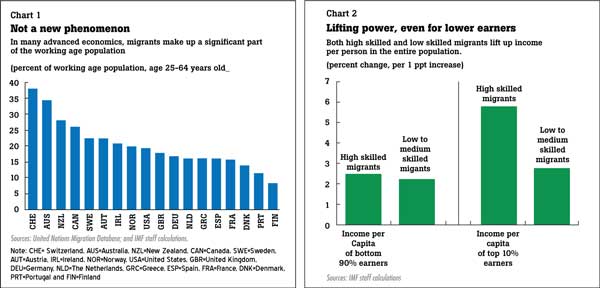28 Oct 2016 - {{hitsCtrl.values.hits}}

Migration, no matter how controversial politically, makes sense economically. A new IMF study  shows that, over the longer term, both high- and low-skilled workers who migrate bring benefits to their new home countries by increasing income per person and living standards.
shows that, over the longer term, both high- and low-skilled workers who migrate bring benefits to their new home countries by increasing income per person and living standards.
High-skilled migrants bring diverse talent and expertise, while low-skilled migrants fill essential occupations for which natives are in short supply and allow natives to be employed at higher-skilled jobs. Moreover, the gains are broadly shared by the population. It may therefore be well-worth shouldering the short-term costs to help integrate these new workers.
Migration nothing new
Rhetoric surrounding migration has turned more negative in recent years. Yet, migration is not a new phenomenon. While the recent refugee surge has made it a hot-button issue, advanced economies already have a large and growing population of migrants (Chart 1).
They constitute 15 to 20 percent of the working-age population in many advanced economies, and around 30 percent in some Anglo-Saxon countries such as Australia and New Zealand. Between 1990 and 2015, immigrants accounted for half of the growth in working age population of advanced economies. They are essential to ensure the future workforce in most advanced economies, where the working-age population would shrink over the next decade without further immigration.
While the stock of low-skilled migrants has been the largest (and broadly constant in percent of adult population over time), the share of high-skilled has been on the rise. Anglo-Saxon countries tend to have a higher proportion of high-skilled migrants than continental European and Nordic countries.
As migrants on average tend to be younger than their adopted country’s native-born population, they help increase the share of working age population. This is the best known channel through which migration increases income per person. But as this new study shows, it is by far not the most important one.

Migration can be boon
The study found that the most important channel through which the arrival of migrant workers affects income per person is by increasing labor productivity (Chart 2).
Migrants increase GDP per person and productivity: A 1 percentage point increase in the share of migrants in the adult population increases GDP per person in advanced economies by up to 2 percent in the longer term. This increase comes primarily from an increase in labour productivity, instead of an increase in the workforce-to-population ratio.
Both high and low-skilled migrants improve productivity: The gains migrants bring are not exclusive to high-skilled workers with specific knowledge and diverse skills. Low-skilled migrants also have a significant impact on overall productivity by complementing the existing skill set of the population:
Low-skilled migrants fill essential occupations for which the native-born population is in short supply, contributing to a more efficient functioning of the economy;
When low-skilled migrants take up more manual routine tasks, the native-born population tend to move to more complex occupations that require language and communication skills in which they have a comparative advantage; and
In what is a key example of complementarity, low-skilled migrants provide housekeeping and childcare services (the “nanny effect”) and thus allow native-born women to return to work, or work longer hours. Indeed, wherever more low-skilled migrants are present, more high-skilled females participate in the labor force.
Prosperity broadly shared: An increase in the migrant share benefits the average income per person of both the bottom 90 percent and the top 10 percent of earners, even though high-skilled migration benefits more the average income of top earners. In addition, the presence of migrants does not seem to increase inequality within the bottom 90 percent of earners.
More work to do
Immigration can bring substantial benefits to advanced economies, in terms of higher per capita GDP and standards of living. These gains are broadly shared by the population. But the key to reaping these benefits is to address the challenges posed by migration in the short term and, in particular, to ensure migrants are integrated into the labor market.
The policies to accomplish this include: language training, job search support, better recognition of the education and work experience of migrants, and lower barriers to entrepreneurship.
While integrating migrants can add to fiscal cost pressures in the short run, these policies allow migrants to obtain and keep a job at a relevant skill level, and increasingly contribute to the fiscal accounts.
At the same time, native workers, too, require some help to adjust, including by upgrading their skills. Policymakers also need to avoid possible overburdening of public services such as health care and education to contain possible buildup of social tensions.
(Florence Jaumotte is a senior economist in the IMF’s Research Department. Ksenia Koloskova is an economist in the Multilateral Surveillance Division of the IMF’s Research Department and Sweta C. Saxena is a senior economist in the IMF’s Research Department)
10 Jan 2025 41 minute ago
10 Jan 2025 46 minute ago
10 Jan 2025 2 hours ago
10 Jan 2025 2 hours ago
10 Jan 2025 2 hours ago